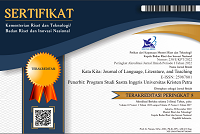Types of Question and Questioning Tactics Used by The Teacher of Children 3A Class
(1) Petra Christian University Jl. Siwalankerto No.121-131, Siwalankerto, Wonocolo Surabaya
(*) Corresponding Author
Abstract
Questioning is one of the most important classroom activities. This study is conducted to find out the/ types of question and questioning tactics used by the teacher of Children 3A class at Petra Language Center (PLC). The theory used was from Wragg and Brown (2001). The data were all the questions asked by the teacher during the class meetings related to the lesson taken from two meetings, each lasted in 60 minutes. I used classroom observation as the instrument to collect my data. From the study, out of the three common types of questions, I found out that only two types of questions were used, i.e conceptual and empirical question. Meanwhile, only six questioning tactics were used, i.e structuring, directing and distributing, pitching and putting clearly, pausing and pacing, listening to replies and responding and sequencing. I concluded that the teacher of Children 3A class asked different types of question and used various questioning tactics to check students understanding by asking the meanings and definitions since students are in the beginner level, thus giving equal opportunities to every students to answer questions.
Keywords
Full Text:
PDFReferences
Brock, C. A. (1986). The effect of referential question on ESL classroom discourse. TESOL Quarterly, 20, (1), 46-59.
Cameron, L. (2005). Teaching languages to young learners (8th ed.). Cambridge: Cambridge University Press.
Ellis, R. (1990). Instructed second language acquisition: Learning in the classroom. Oxford: Basil Blackwell Ltd.
Farahian, M. and Rezaee, M. (2012). A case study of an EFL teacher’s type of questions: an investigation into classroom interaction. Procedia-Social and Behavioral Sciences, 47, 161-167.
French, P. and Maclure, M. (1983) ‘Teachers’ questions and pupil answers: an investigation of questions and answers in the infant classroom’, in Stubbs, M. and Hillier, H. (eds), Readings in Language, Schools and Classrooms, second edition, London: Methuen.
Gall, M. D. (1970). The Use of Questions in Teaching, Review of Educational Research, 40, 707-721.
Kramsch, C. J. (1986). From language proficiency to interactional competence. The Modern Language Journal, 70(4), 366-372.
Suryanti, N. (2015). Classroom Interaction Strategies Employed by English Teachers at Lower Secondary Schools. TEFLIN Journal, 26(2), 247-264. doi: http://dx.doi.org/10.15639/teflinjournal.v26i2
Wragg, E. C., & Brown. (2001). Questioning in the Primary School. London: Leverhulme Primary Project Classroom Skills Series. London and New York
Wu, K. Y. (1993). Classroom interaction and teacher questions revisited. RELC Journal, 24(22), 49-68.
Zacharias, N. T. (2012) Qualitative research methods for second language education: A coursebook. Cambridge: Cambridge Scholars Publishing.
DOI: https://doi.org/10.9744/katakita.6.1.43-51
Refbacks
- There are currently no refbacks.
Supported by:
Indexed in:
Tools:
Stats (installed since 17 December 2018)
View My Stats













